Declaration: I received an Aquagear Survivor filter bottle for free from BackpackingLight.co.uk for review. The unit arrived through the post in May 2008 with a note that “we would appreciate an A4 report as to the way you have used the product and the impact it has made on your outdoor activities.” Here follows the report.
Technical information: I’m not a virologist, so you can read the list of viruses and infections that it filters out off the website and listen to the podcast, or go to the manufacturer’s site. The main advice is to only filter water from a running non-saline watercourse. There is also a removable pocket in the base of the bottle that allows iodine or chlorine tablets to be added. Inside the base unit is a mesh to filter out sediment as the bottle is filled from the base, and drunk through the lid spout.
I drink water on the move from my pack-mounted CamelBak unit (Sto-away 70/2.1litre). To cut down on pack weight, I’ll estimate how much water I’ll want to carry and generally a 1 litre carry will do me in the Cairngorms of Scotland. We aren’t short of water here.
For a “packs-off” stop, I got into the habit of drinking from a running water-source instead of draining the CamelBak. To refill the hydration system, I would either have to remove it from the inside of my regular Osprey Atmos pack or rig up a refill system (as described on the Southern Upland Way). So I got into the habit of carrying a plastic pop bottle that I could fill up and sup out of. When the tent was pitched, I could use the bottle to fill up the hydration sack instead of forcing the sack into a stream. If the water was dodgy, I would drop in some Aqua Mira solution and wait about 15 minutes.
When I got the Aquagear bottle, I simply replaced the pop bottle with the filtration bottle. It lives in the side pocket of the backpack. Some people are able to forego the hydration system and reach into the pocket of their pack – I am not that flexible. I bought a 1 litre Nalgene bottle carrier to use on my belt as a holster on day trips. Though I have not used it so far.
When I want to fill the bottle up, I simply remove the base plate, leave on the sieve and fill up the bottle. I can then pump it through the filter into the CamelBak. Keeping the top of the bottle out of contaminated water can be an issue, but the spout has a cover on it that should stop water contaminating the spout. I tend to fill from flowing water anyway, aiming for small waterfalls. If encamped, I found that the GSI bowl almost fills the bottle in one scoop.
Here is my initial out of the box look, and the first use in Glen Ey in the Cairngorms.
Nothing much has really changed over the Summer. I drink out of the Aquagear Survivor at packs-off stops, and I use it to fill my CamelBak at night and in the morning. Sometimes I will filter the water through the bottle into the CamelBak, and sometimes I won’t – it depends on my trust in the water source. I carry a few chlorine tablets (from a Lifesystems packet) in a zip-lock bag in my first aid kit, just in case the water is very dodgy.
For those of you interested in such things, the manufacturer states that the unit weighs 180 grams (empty). For me, it is now a standard piece of kit and is much more useful than an old pop bottle.
 Getting on with my life and thinking about things.
Getting on with my life and thinking about things.


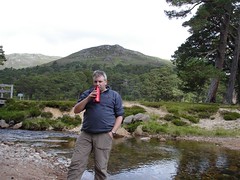







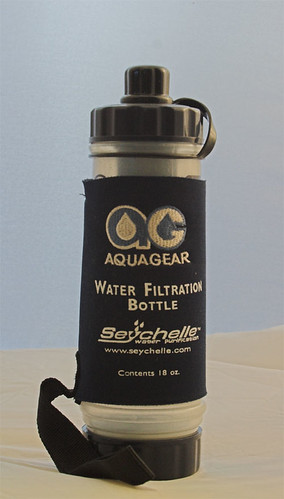
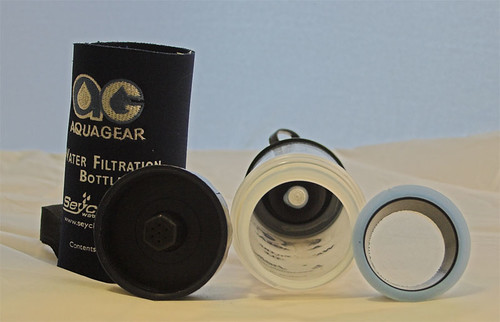
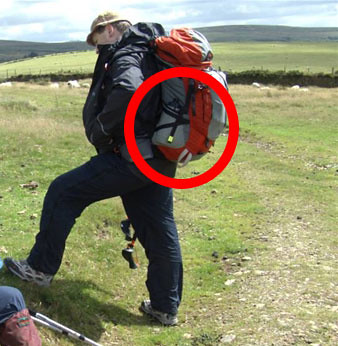
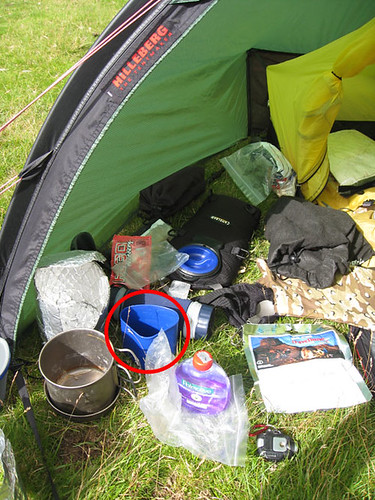
2 comments:
"There is also a removable pocket in the base of the bottle that allows iodine or chlorine tablets to be added."
This is good, especially if you plan on storing the water for a long period of time (perhaps if you have multiple bottles on a long hike). I think it's easy to forget that since chlorine was introduced into the mainstream 100 years ago it's worked to virtually eliminate most water born illnesses. Having done some work for the American Chemistry Council, I can't stress this fact enough
I like designs that have had some thought put into them, Jolie. The wee pill holder just unscrews off the inside of the baseplate and the chemicals can work their magic instead of being loose inside the bottle. The top of the pill-holder is perforated.
I carry some treatment tablets with me just in case the water looks dodgy. And some immodium in case I failed to notice.
Post a Comment